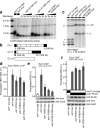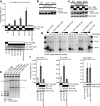Tel1ATM and Rad3ATR kinases promote Ccq1-Est1 interaction to maintain telomeres in fission yeast
- PMID: 22101932
- PMCID: PMC3230746
- DOI: 10.1038/nsmb.2187
Tel1ATM and Rad3ATR kinases promote Ccq1-Est1 interaction to maintain telomeres in fission yeast
Abstract
The evolutionarily conserved shelterin complex has been shown to play both positive and negative roles in telomerase regulation in mammals and fission yeast. Although shelterin prevents the checkpoint kinases ATM and ATR from fully activating DNA damage responses at telomeres in mammalian cells, those kinases also promote telomere maintenance. In fission yeast, cells lacking both Tel1 (ATM ortholog) and Rad3 (ATR ortholog) fail to recruit telomerase to telomeres and survive by circularizing chromosomes. However, the critical telomere substrate(s) of Tel1(ATM) and Rad3(ATR) was unknown. Here we show that phosphorylation of the shelterin subunit Ccq1 on Thr93, redundantly mediated by Tel1(ATM) and/or Rad3(ATR), is essential for telomerase association with telomeres. In addition, we show that the telomerase subunit Est1 interacts directly with the phosphorylated Thr93 of Ccq1 to ensure telomere maintenance. The shelterin subunits Taz1, Rap1 and Poz1 (previously established inhibitors of telomerase) were also found to negatively regulate Ccq1 phosphorylation. These findings establish Tel1(ATM)/Rad3(ATR)-dependent Ccq1 Thr93 phosphorylation as a critical regulator of telomere maintenance in fission yeast.
Figures




Similar articles
-
Tpz1-Ccq1 and Tpz1-Poz1 interactions within fission yeast shelterin modulate Ccq1 Thr93 phosphorylation and telomerase recruitment.PLoS Genet. 2014 Oct 16;10(10):e1004708. doi: 10.1371/journal.pgen.1004708. eCollection 2014 Oct. PLoS Genet. 2014. PMID: 25330395 Free PMC article.
-
Tel1(ATM) and Rad3(ATR) phosphorylate the telomere protein Ccq1 to recruit telomerase and elongate telomeres in fission yeast.Genes Dev. 2012 Feb 1;26(3):241-6. doi: 10.1101/gad.177873.111. Genes Dev. 2012. PMID: 22302936 Free PMC article.
-
Fission yeast Tel1(ATM) and Rad3(ATR) promote telomere protection and telomerase recruitment.PLoS Genet. 2009 Aug;5(8):e1000622. doi: 10.1371/journal.pgen.1000622. Epub 2009 Aug 28. PLoS Genet. 2009. PMID: 19714219 Free PMC article.
-
The regulation of the DNA damage response at telomeres: focus on kinases.Biochem Soc Trans. 2021 Apr 30;49(2):933-943. doi: 10.1042/BST20200856. Biochem Soc Trans. 2021. PMID: 33769480 Review.
-
Rad3 and Sty1 function in Schizosaccharomyces pombe: an integrated response to DNA damage and environmental stress?Mol Microbiol. 2008 Apr;68(2):246-54. doi: 10.1111/j.1365-2958.2008.06147.x. Mol Microbiol. 2008. PMID: 18366437 Review.
Cited by
-
Structural Basis for Shelterin Bridge Assembly.Mol Cell. 2017 Nov 16;68(4):698-714.e5. doi: 10.1016/j.molcel.2017.10.032. Mol Cell. 2017. PMID: 29149597 Free PMC article.
-
Tpz1TPP1 SUMOylation reveals evolutionary conservation of SUMO-dependent Stn1 telomere association.EMBO Rep. 2014 Aug;15(8):871-7. doi: 10.15252/embr.201438919. Epub 2014 Jun 12. EMBO Rep. 2014. PMID: 24925530 Free PMC article.
-
ATM and ATR Signaling Regulate the Recruitment of Human Telomerase to Telomeres.Cell Rep. 2015 Nov 24;13(8):1633-46. doi: 10.1016/j.celrep.2015.10.041. Epub 2015 Nov 12. Cell Rep. 2015. PMID: 26586433 Free PMC article.
-
A popular engagement at the ends.Nat Struct Mol Biol. 2013 Jan;20(1):10-2. doi: 10.1038/nsmb.2483. Nat Struct Mol Biol. 2013. PMID: 23288360 Free PMC article.
-
Ccq1 restrains Mre11-mediated degradation to distinguish short telomeres from double-strand breaks.Nucleic Acids Res. 2024 Apr 24;52(7):3722-3739. doi: 10.1093/nar/gkae044. Nucleic Acids Res. 2024. PMID: 38321948 Free PMC article.
References
-
- Palm W, de Lange T. How shelterin protects mammalian telomeres. Annu Rev Genet. 2008;42:301–34. - PubMed
-
- Miyoshi T, Kanoh J, Saito M, Ishikawa F. Fission yeast Pot1-Tpp1 protects telomeres and regulates telomere length. Science. 2008;320:1341–4. - PubMed
-
- Flory MR, Carson AR, Muller EG, Aebersold R. An SMC-domain protein in fission yeast links telomeres to the meiotic centrosome. Mol Cell. 2004;16:619–30. - PubMed
Publication types
MeSH terms
Substances
Grants and funding
LinkOut - more resources
Full Text Sources
Other Literature Sources
Molecular Biology Databases
Research Materials
Miscellaneous

